Olive bread with rosemary is a truly incredible bread that’s loaded with flavor. Its texture and taste make it an excellent choice for sandwiches, but it’s equally good with a little olive oil for dipping. Our step-by-step instructions take the guesswork out of making this bread enabling you to recreate this bakery-worthy bread in your own home!
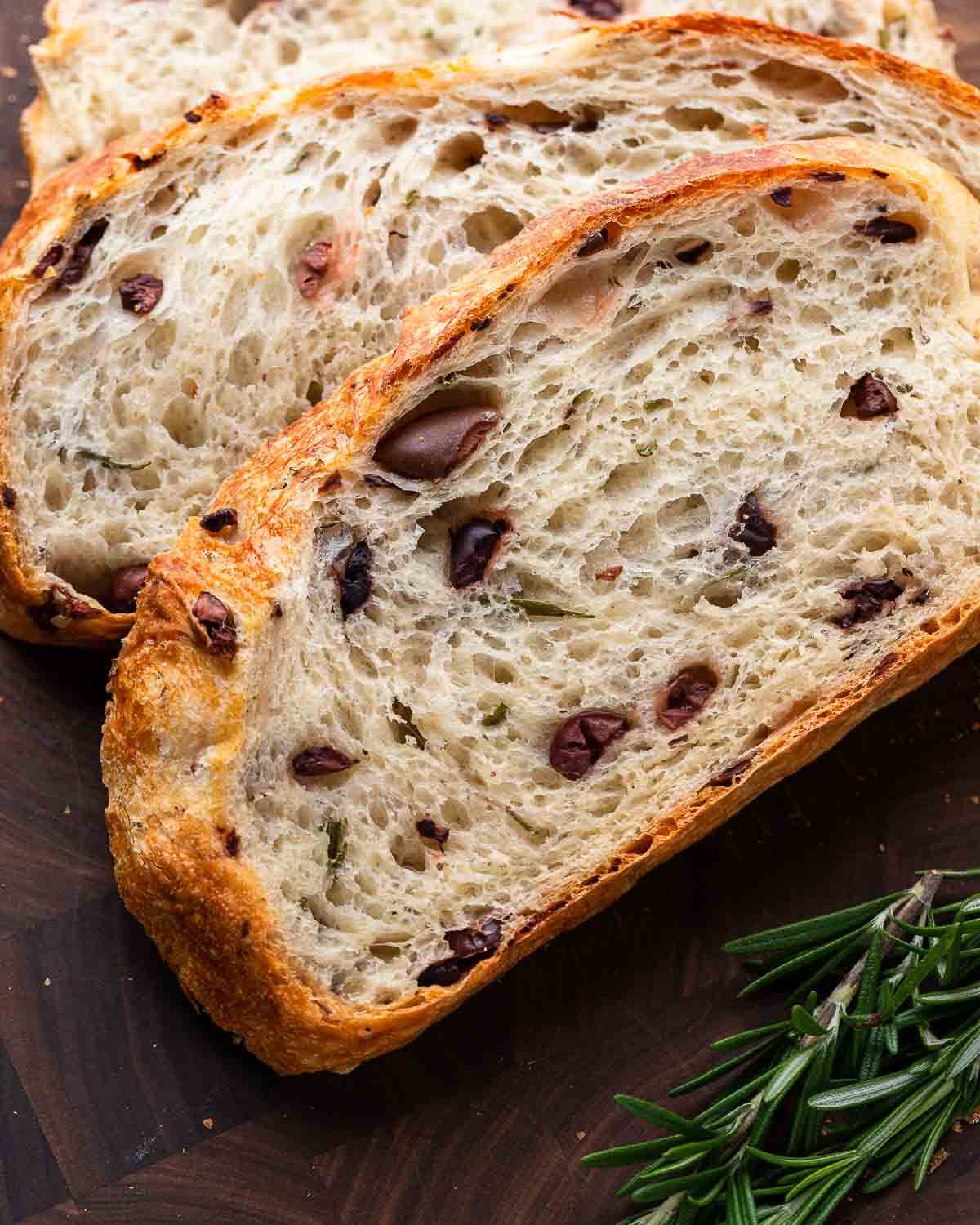
There’s nothing quite like a homemade loaf of bread, but for many, it can be intimidating.
It’s our goal to remove the guesswork from making this homemade olive bread so you can feel empowered to do this at home.
The process does require you to start a day ahead of the actual breadmaking, but one bite and you’ll feel it’s worth it.
This olive oil and rosemary bread is just perfect for sandwiches, but we also love it with olive oil or butter.
We also enjoy a chunk of this bread (and other bread, like focaccia) with soup, like pasta fazool or minestrone, and it is truly an impressive loaf to bring to a friend or family member’s home.
How to make it
Each number corresponds to the numbered written steps below.
Want To Save This Recipe?
- The night before baking the bread, make the poolish. In a large bowl, mix together 1 1/4 cups (160g) of bread flour, 3/4 cup (160g) water heated to 80f, and 1/8 teaspoon (.35g) of instant yeast. Cover the bowl and allow it to sit overnight in a room at 70f. Note: We recommend using an instant-read thermometer to check the water temperature.
- The poolish will be ready the next morning when it has risen and is covered with tiny bubbles. It takes about 10-12 hours to get to this point, but can take less or more time depending on the room temperature. The poolish needs to be used before it collapses. If you plan to make your bread later in the day, refrigerate it to prevent collapsing.
- Drain, dry, and chop 1 1/2 cups of pitted olives and set aside. Chop 1 tablespoon worth of fresh rosemary leaves. In a large bowl or square container, mix together 3 1/4 cups (380g) of bread flour, 1 1/2 teaspoons (4.5g) of instant dry yeast, 2 teaspoons of diastatic malt powder, and 2 teaspoons of fine sea salt. Note: Diastatic malt powder is optional, however, it does aid in browning.
- Add 1 cup (245g) of water warmed to 80f, the poolish, the olives, rosemary, and 2 teaspoons of extra virgin olive oil.
- Using your hands, mix and combine the ingredients, stretching the dough to thoroughly mix. This will take about 5 minutes, so take your time.
- Cover and allow the dough to sit for 60 minutes.
- After 60 minutes move the dough to the floured work surface and lay it out. Dust a bench scraper with flour and use it to lift the dough.
- Pull the dough, then stretch and fold it over itself.
- Rotate the dough 90 degrees, then stretch and fold the dough 3 more times, rotating after each stretch and fold.
- Use the scraper to gently move the dough back into the container. Cover it and allow it to sit for another 30 minutes. Note: If you’d like you can stretch and fold the dough in the container with just your hands. Simply dip your hands into a bowl of water before each stretch and fold to prevent sticking.
- After 30 minutes, do another 4 stretches and folds.
- Taking care to not degas the dough, shape it into a round loaf. Place the dough ball seam side down into a bowl lined with a piece of parchment paper. Cover with a towel or plastic and let it rise for 90 minutes or until it doubles in size. 45 minutes before baking, preheat the oven to 450f and set the rack toward the middle level leaving enough space to hold a Dutch oven with its lid. Place a 5-6 quart covered Dutch oven onto the rack and close the oven.
- Right before the 45 minutes have elapsed, score the dough with a 1/4″ deep slit running the length of the loaf at a shallow angle.
- Remove the Dutch oven from the oven being careful to avoid burning yourself. Remove the lid, and grab each side of the parchment paper, gently lowering the dough into the Dutch oven.
- Quickly cover with the lid and place in the oven and bake for 30 minutes.
- After 30 minutes remove the lid and allow the bread to bake for another 25-35 minutes. The loaf is done when it feels hollow when knocked on. If it doesn’t feel hollow, simply place the loaf straight onto the oven rack and bake for another 5 minutes, then check again. Once finished baking, place the olive bread onto a wire rack to cool and wait at least 90 minutes before slicing. Enjoy!
Top tips
- The poolish. Depending on the temperature of your room, the poolish should be ready in 10-12 hours. It should either be used to make the bread, or it should be moved to the refrigerator. Refrigeration will prevent overfermentation and collapsing. The poolish can be held in the fridge for a max of up to 3 days.
- Stretch and fold. We use a stretch-and-fold method for the olive bread dough. This helps the dough develop large gluten strands, and it introduces oxygen when folding which is necessary for gluten formation. This method also stimulates fermentation by helping the yeast produce more gas which also helps to develop the gluten. All of this helps to make the dough easier to shape and for a higher rise and better structure.
- Olives. We used kalamata olives but you can use any pitted olives you like, such as oil-cured black olives, or Castelvetrano.
- Knock on the bread. Be sure to knock on the bread to check for doneness. If the bread sounds hollow, you’re good. If not, place it back in the oven (it can go directly on the oven rack at this point) for another 5 minutes, then give it another knock.
More ways to enjoy olive bread
Here are a few of our favorite recipes to serve with olive bread. We hope you enjoy!
- Tuscan white bean soup – the flavor from the roasted garlic and cannellini beans pair perfectly with olive bread.
- Peperonata – bell peppers, onions, and tomatoes stewed together make the perfect topping for bread!
- Ciambotta – this summer vegetable soup complements this bread in every way!
If you’ve enjoyed this olive bread recipe or any recipe on this site, give it a 5-star rating and leave a review.
We strive to satisfy a number of learning styles. If you prefer to learn by watching, you can find most of our recipes on YouTube and our Facebook Page.
Olive Bread

Ingredients
For the poolish
- 1 1/4 cups (160g) bread flour
- 3/4 cup (160g) water 80f
- 1/8 teaspoon (.35g) instant yeast I use SAF brand
For the olive bread
- 1 1/2 cups pitted olives (can use kalamata, oil-cured, Castelvetrano) chopped, drained, and patted dry
- 1 tablespoon rosemary leaves chopped
- 2 teaspoons fine sea salt
- 3 1/4 cups (380g) bread flour
- 2 teaspoons extra virgin olive oil
- 1 1/2 teaspoons (4.5g) instant dry yeast I use SAF brand
- 2 teaspoons Diastatic malt powder optional
- 1 cup (245g) water 80f
Want To Save This Recipe?
Instructions
Make the poolish
- The night before baking the bread, mix together the ingredients and cover overnight in a 70f room. The poolish will be ready the next morning when it has risen and is covered with small bubbles. It should take 10-12 hours but can be more or less depending on room temp. The poolish needs to be used before it collapses or it should be refrigerated if you want to make the bread later in the day.
For the olive bread
- In a large bowl or square container, mix together the flour, yeast, diastatic malt powder, and salt.
- Add the water, poolish, olives, rosemary, and olive oil and mix by hand to combine. Stretch the dough to thoroughly mix it. This should take about 5 minutes to mix. Take your time. Cover and let the dough sit for 60 minutes.
- After 60 minutes bring the dough to a floured work surface and lay it out. Using a dough scraper with a bit of bench flour get under the dough and pull it to stretch then fold the dough over itself and rotate it 90 degrees. Stretch and fold the dough 3 more times while rotating after each stretch and fold. Use the scraper and gently place the dough back into the container. After 30 minutes, do another 4 stretch and folds. Note: You can also stretch and fold the dough right in the container. To do this dip hands into a bowl of water before each stretch and fold. Either way works fine!
- Being gentle to not degas the dough, form a round loaf shape. Place the dough ball seam side down into a bowl lined with a piece of parchment paper. Cover with a towel or plastic and let it rise for 90 minutes or until it approximately doubles in size.
- 45 minutes before baking, preheat the oven to 450f and set the rack towards the middle level leaving enough space to hold a Dutch oven with its lid. Place a 5-6 quart covered Dutch oven onto the rack and close the oven.
- Right before 45 minutes have elapsed, score the dough with a 1/4" deep slit running the length of the loaf at a shallow angle.
- Remove the Dutch oven from the oven being careful to avoid burning yourself. Remove the lid and quickly grabbing each side of the parchment paper place the loaf with the parchment paper into the Dutch oven and cover. Place the Dutch oven into the oven and bake for 30 minutes.
- After 30 minutes remove the Dutch oven's lid and let the bread bake for another 25-35 minutes. The loaf is finished cooking when it feels hollow when knocked on. If it doesn't feel hollow, simply place the loaf straight onto the oven rack and bake for another 5 minutes and check again.
- Once finished baking, place the olive bread onto a wire rack to cool and wait at least 90 minutes before slicing. Enjoy!
Notes
- I always use SAF instant yeast for all of my bread and pizza dough recipes.
- Diastatic malt powder helps aid in browning but is not required. It can be omitted.
- The calorie amount reflects 1 large loaf.
Nutrition
Nutrition information is automatically calculated, so should only be used as an approximation.
Follow Me
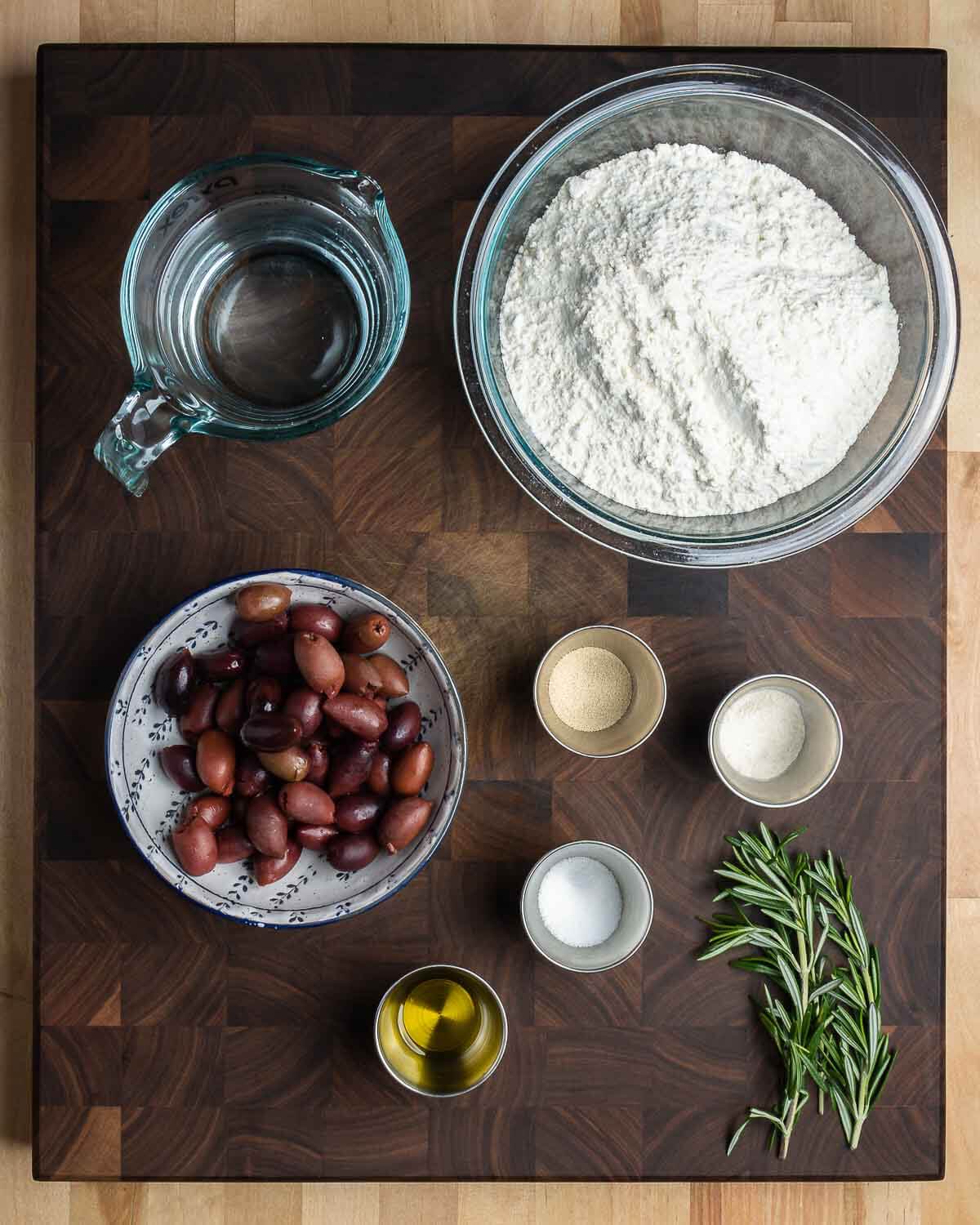
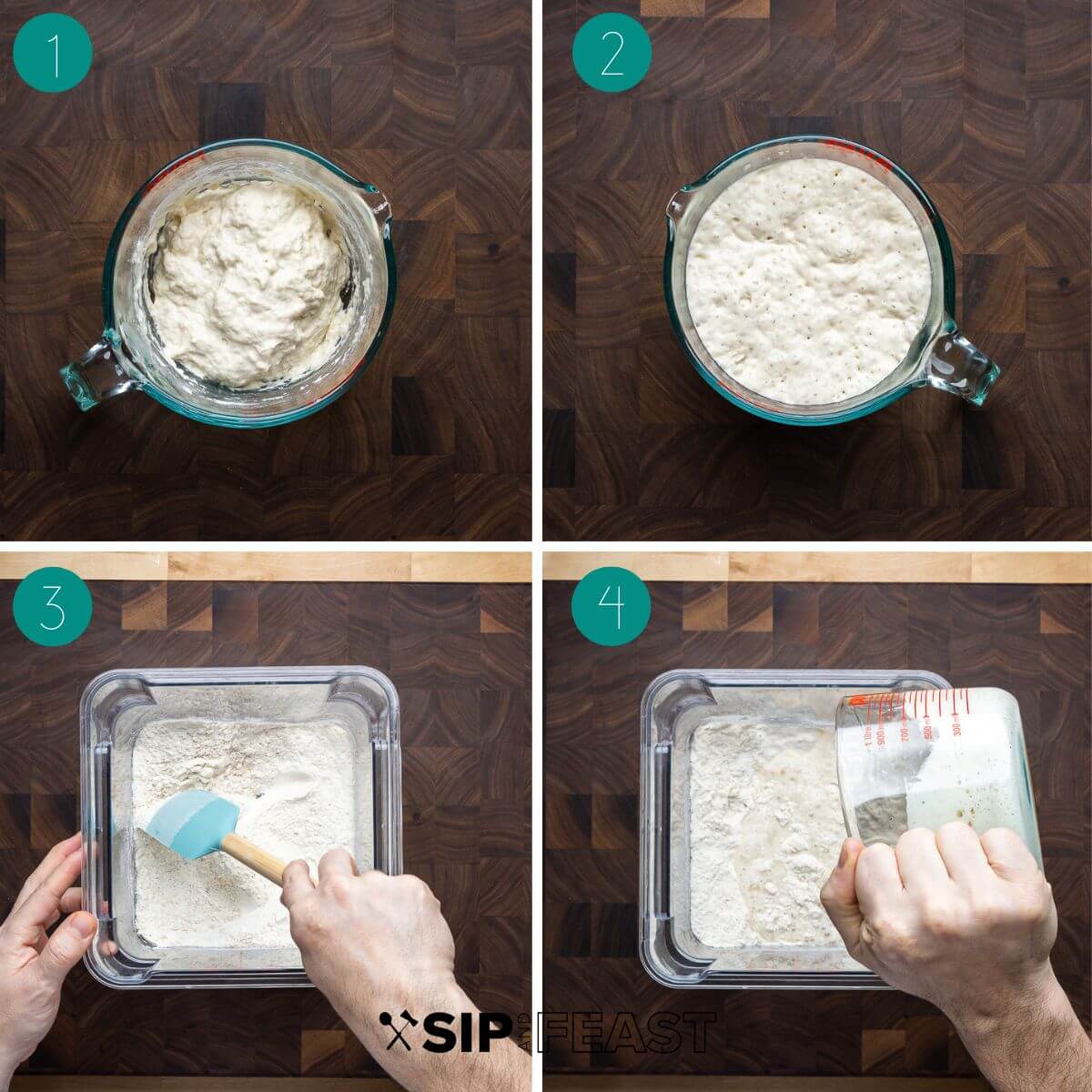
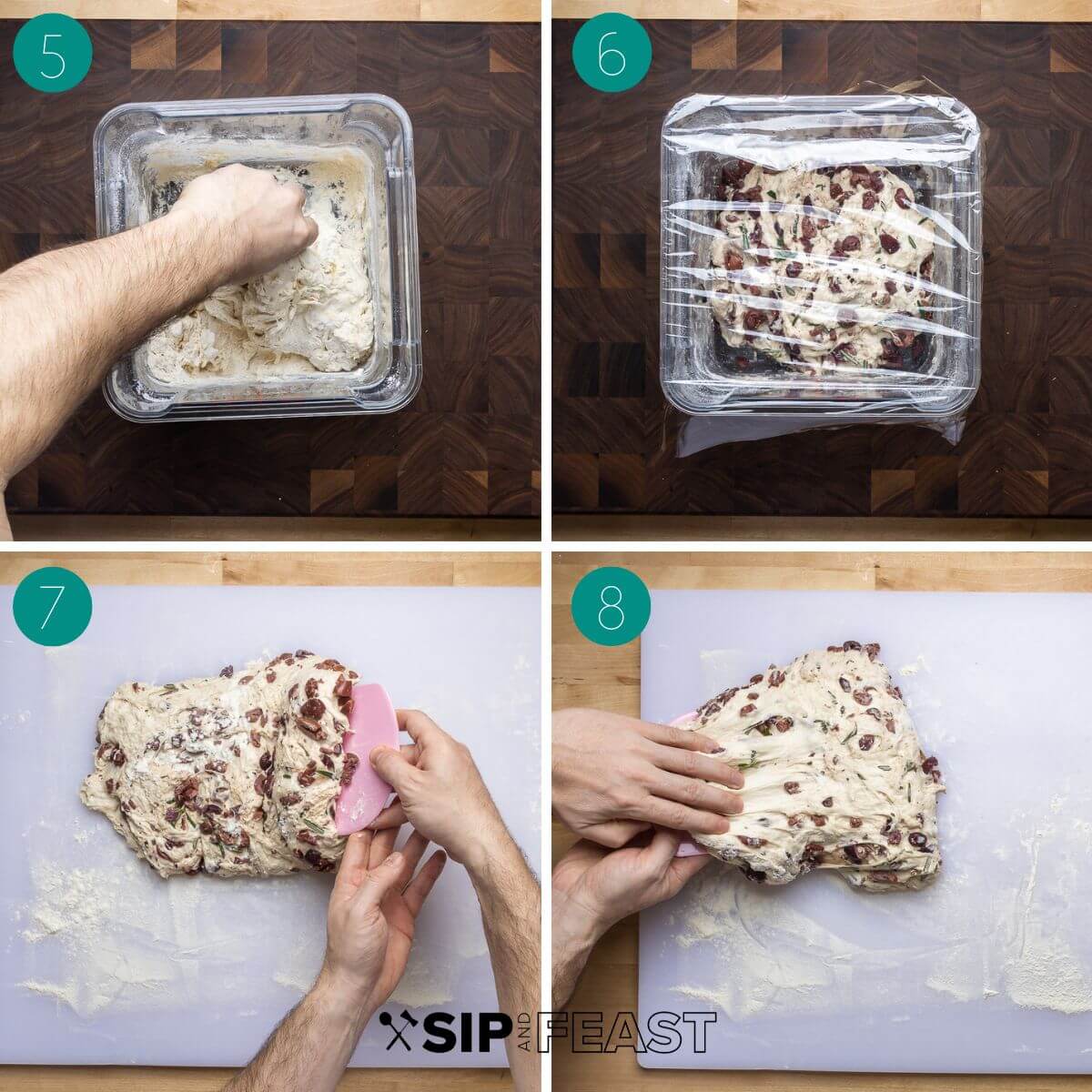
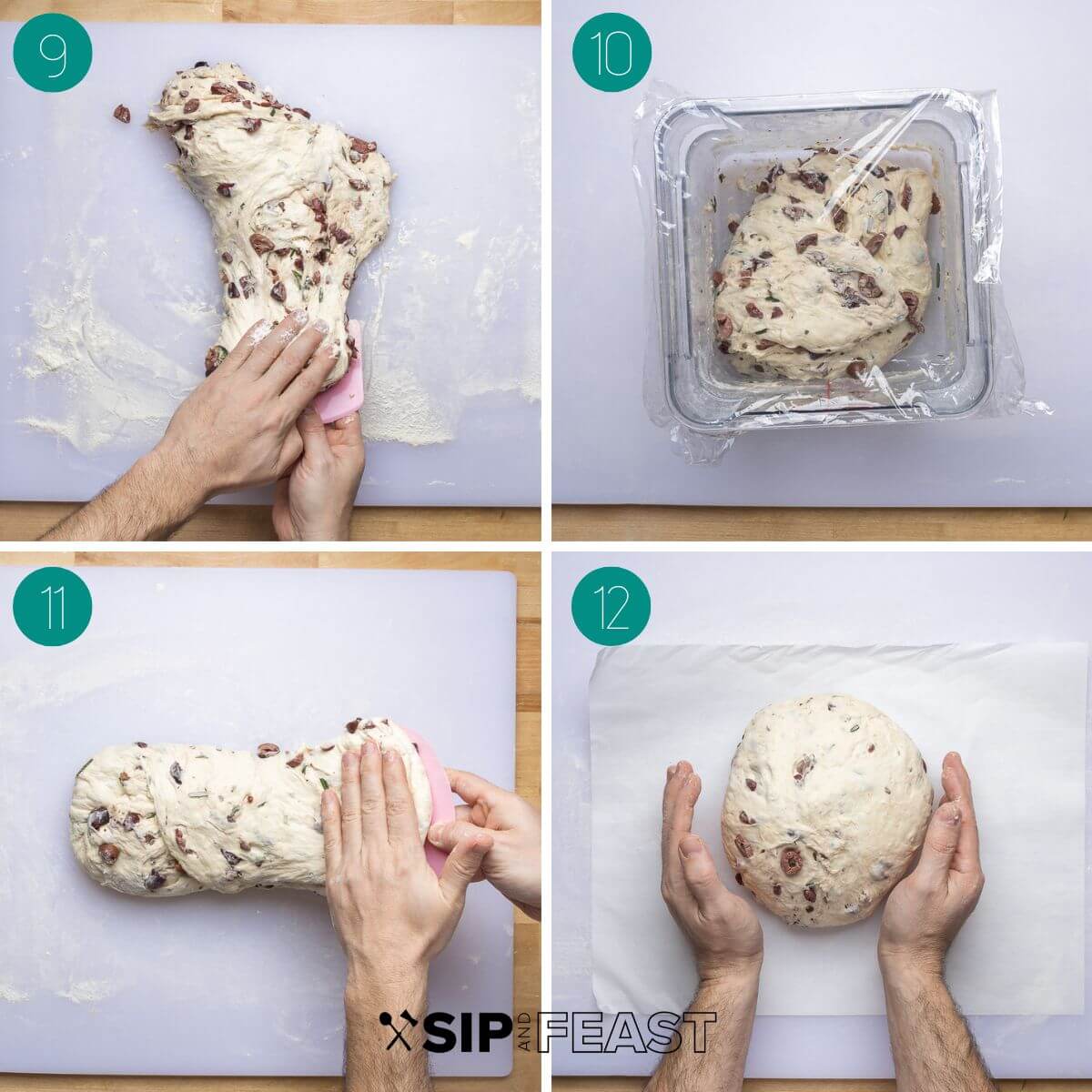
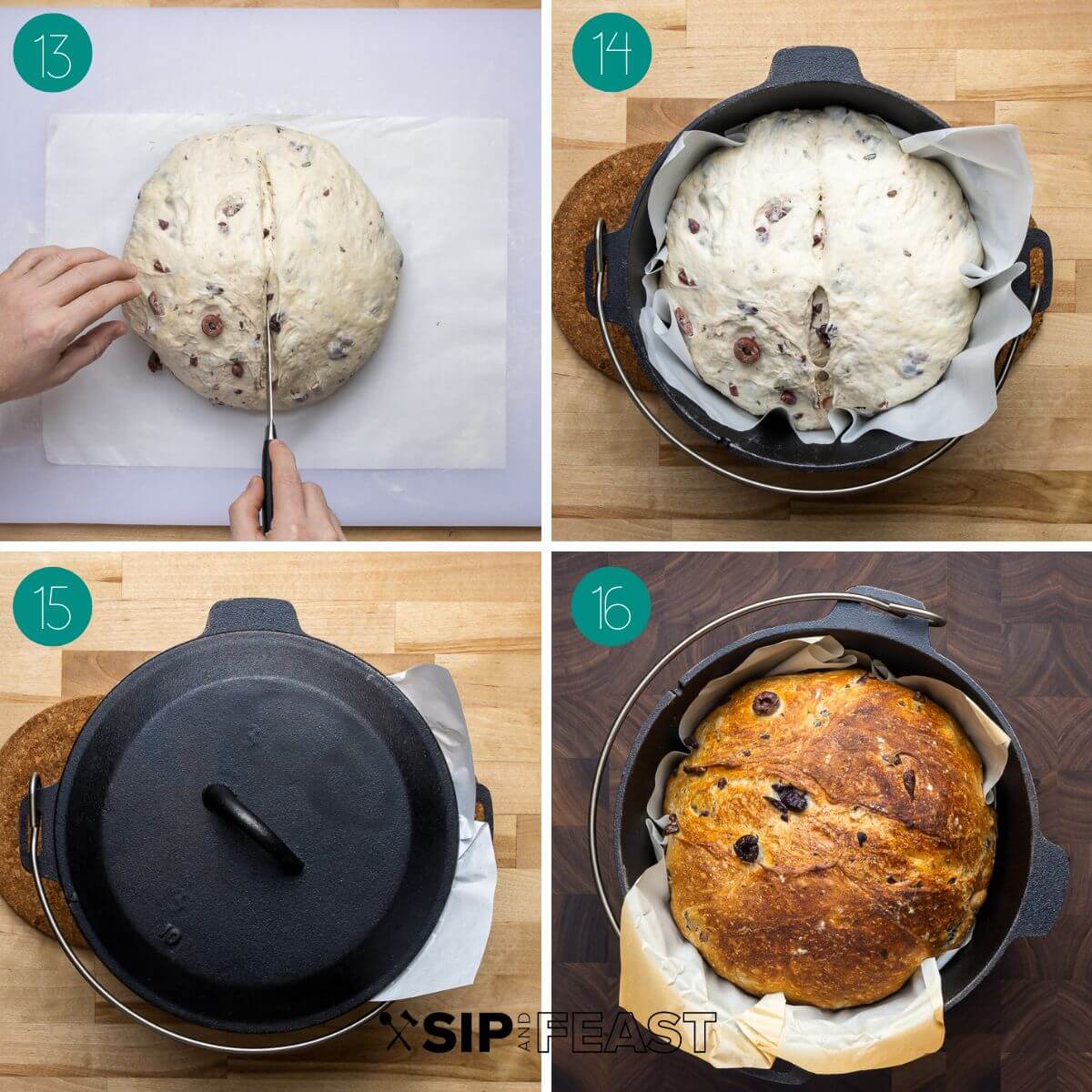
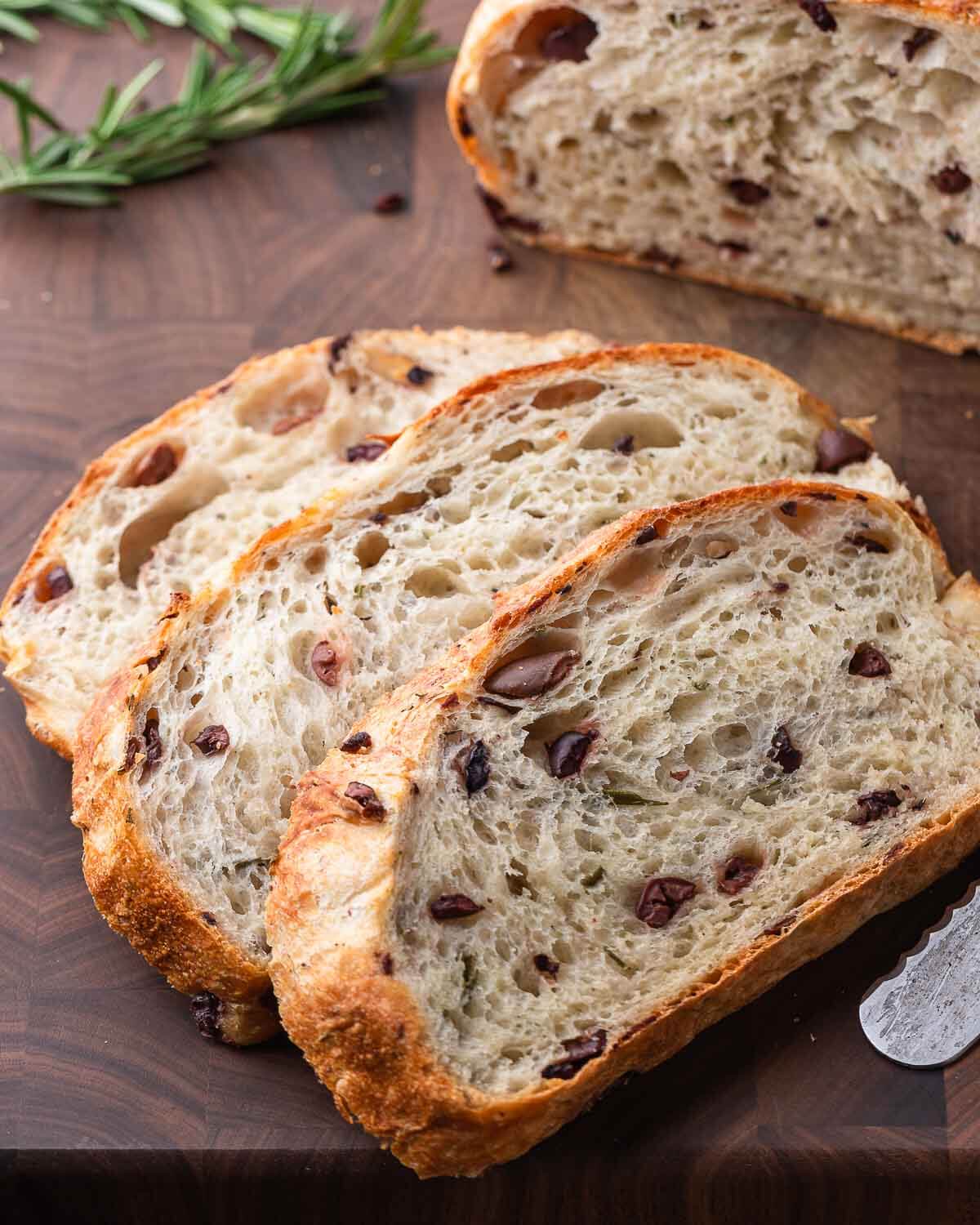
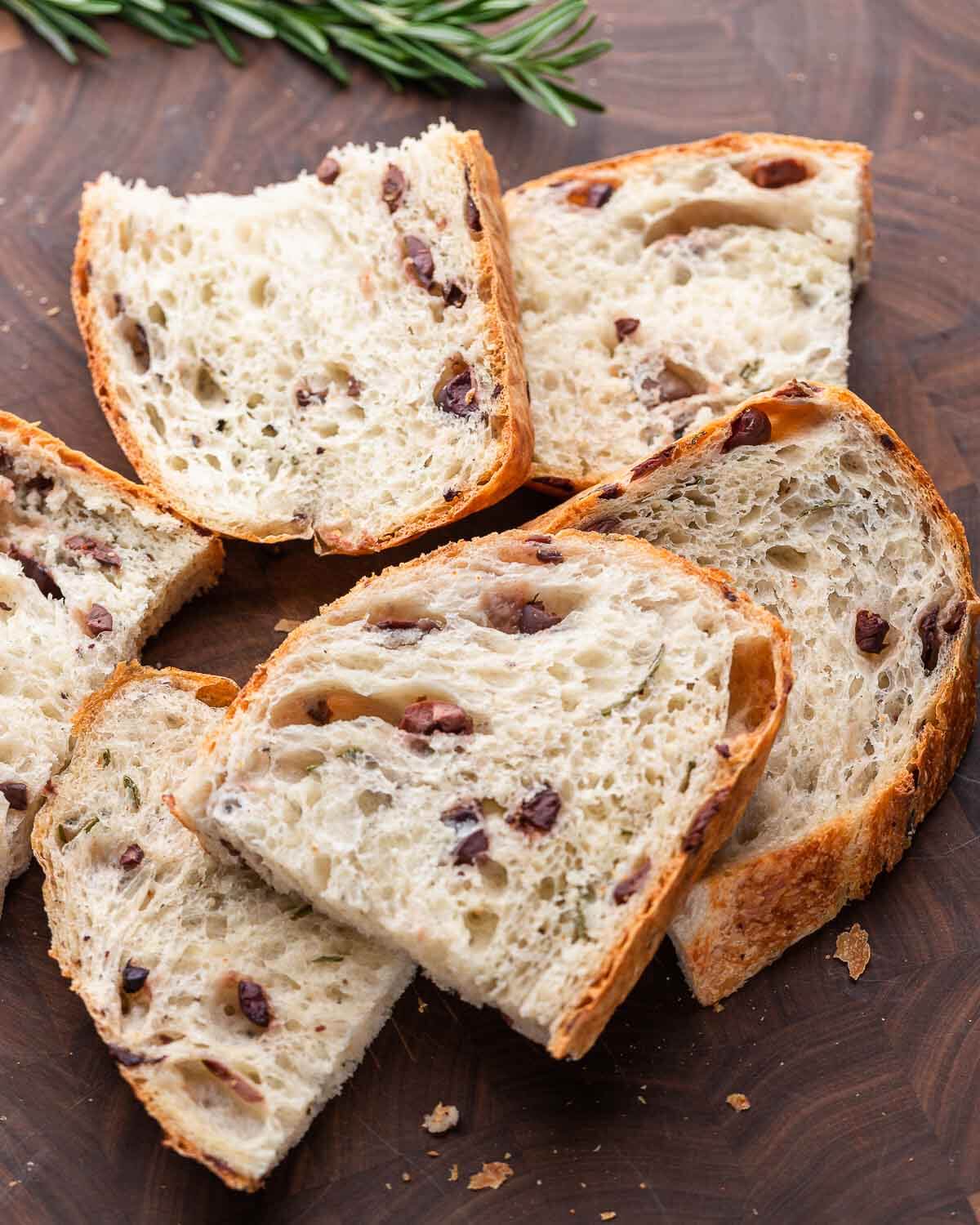







how do you adjust the recipe for active yeast? I ended up using a lot more flour because it took water/sugar to activate the yeast. first time bread maker!
Hi Ezra, you shouldn’t have needed additional water to activate the yeast, but the same amount should be used regardless of instant or active yeast. The ratio of flour and water for a poolish should always be 1:1. Sugar is not needed to activate the yeast. Jim does recommend using instant yeast, especially for novice breadmakers.
Amazing! I love the look, texture, and flavor of this bread! I kind of had to set a whole day aside. Not much active time but a lot of babysitting. But really easy and totally worth it! Followed directions exactly. I would add more rosemary next time. I did not use the optional malt and the bread still had a perfect crust. I have never made bread in a pot before. Loved it!
We’re so happy you liked the bread, Jessica!
Could I use the Sourdough starter instead of
poolish ?
Yes, you can.
Hi first I want to say Love that you guys make all these amazing dishes! I’m from Long Island grew up in an Italian home grandpa came here through Ellis Island. I’m looking for a good NY Italian bread recipe. I was hoping you had one but I didn’t see one. Sorry I’m taking up space here to ask…I’m sure this Olive bread is amazing! Keep them coming! I’m loving all your recipes
Thank you
Tina
Hi Tina, Jim is still in the process of testing and perfecting the Italian bread recipe and once he’s happy with it, we will share it here. It takes some time, but he wants to make sure he nails it! Thanks for following along and we’re so happy you’re enjoying the recipes.
Excellent have been waiting patiently have tried a dozen tried and true recipes nothing compares to the great bread sound in the good delis in Jersey. Will wait for this long awaited I one. I am sure it will be great
I cannot say enough about this recipe!
Easy, very little active work time, and to say the taste is perfection is an understatement.
Keep them coming!
Hi Theresa, we’re so happy you hear how much you enjoy this recipe! Thanks for the comment!
What a fabulous recipe!
Looks gorgeous! I’m a sourdough baker and wondered how this recipe would adapt using sourdough starter rather than a poolish. I don’t often have regular yeast in my fridge!
Hi Pam, thanks for the comment! Jim hasn’t tested this recipe with a sourdough starter so can’t say for sure how you’d adapt using a starter. If you happen to try it with your starter, let us know how it turns out!
making it now a lot of steps but I don’t have a dutch oven how will a long loaf clay baker work. Have made bread in it before, thanks much, I used green olives with pimentos in there
Hi Ileen, thanks for the comment. I haven’t tested this in a loaf clay baker so I can’t say for sure. The cover on the Dutch oven is important for developing the crust which is why I recommend using it for this recipe.
yes my clay baker had a lid and the bread came out amazing with green olives but the shape was not what it should have been, the dough was hard to get into the baker so it was dark and crusty an delicious but next time I am getting the dutch over only for the shape, thanks for another great recipe another one shared to pinterest.
Hi Ileen, thanks for reporting back on this one and I’m so happy it worked in your clay baker!
Wonderful instructions. Followed to the letter. I did weigh my flour as I always seen to find I am not consistent I. Scooping with a cup.
Didn’t have the malt powder but my loaf was beautifully brown with out it.
Next time will add more rosemary.
Hi Claire, we’re so happy to hear you enjoyed the olive bread and found the instructions to be helpful. Thank you for your comment!
Fabulous recipe great instructions turned out so good. Served with garlic herb butter and had clam fettuccine with it. It requires time the night before and many steps today but wonderful results. I ordered the malt powder from King Arthur flour.
Hi Velvet, thanks for the comment and I’m so happy to hear you enjoyed the bread!